Impacts Of Harmful Lights
The Hidden Threat of Harmful Lighting in Meat Displays
Conventional Lights Can Damage Meat Quality and Sales
Harsh, unbalanced lighting in a butcher’s refrigerated display can silently wreak havoc on the products. Many butcher shop owners focus on temperature control and sanitation, but overlook an insidious factor: the display case lighting. The truth is, the wrong lighting can discolor meat, accelerate spoilage, drain moisture, and cause product shrink – all of which undermine your business. Studies have shown that not only does light cause meat discoloration, it also encourages the growth of bacteria by raising the surface temperature of products. In short, harmful lighting in your meat case isn’t just an aesthetic issue; it’s a direct threat to your product quality, shelf life, and profits. This section explains the scope of the problem, setting the stage for solutions that can protect your meat displays.
Conventional bulbs found in many refrigerated meat cases emit a spectrum and heat output that’s not food-friendly. The effects may not be immediately obvious, but they are costly. Over time, meats under these lights develop off-colors and spoil faster, forcing you to discount or discard inventory. The impact of poor lighting is often reflected in higher shrink and waste – and ultimately in lost revenue. A butcher shop can’t afford to ignore these hidden costs, especially when a simple change in lighting can address them. Each of the following sections delves into how exactly harmful lighting affects your meat products and why it’s critical to take action.
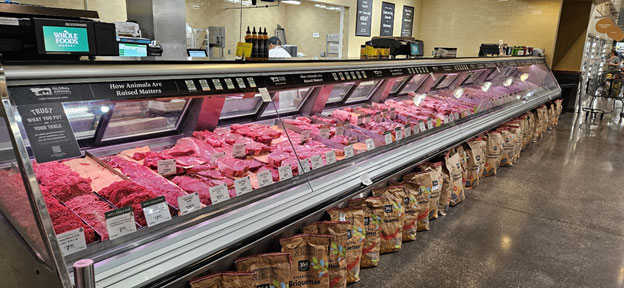
Unappealing Discoloration: How Harmful Lights Change Meat Color
Harsh Lighting Quickly Robs Meat of Its Fresh Color
One of the first things customers notice about meat is its color. Bright red beef, rosy pork, and pink lamb signals freshness, while brown or grey hues suggest old or spoiled meat. Harmful display lighting can quickly drain the appealing color from your products. Ordinary case lights often emit strong wavelengths that trigger oxidation of meat pigments, turning that vibrant red bloom into a dull brown. In fact, research shows that over 40% of consumers judge meat freshness based on color alone. If your steaks or ground beef look even slightly discolored, many shoppers will simply move on – or worse, question your shop’s quality standards.
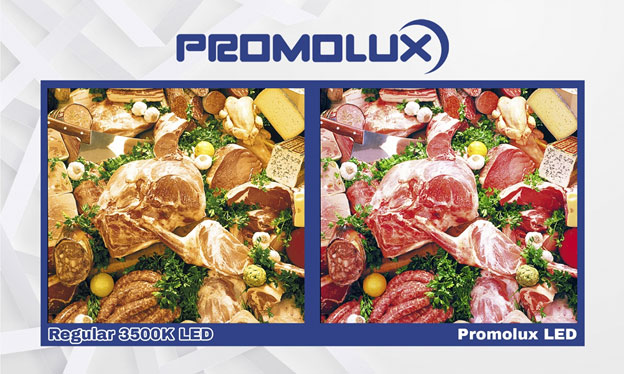
Poor lighting doesn’t just change the color; it creates a color that customers don’t trust. Some older lighting types can cast a yellow or greenish tint on meats, making even fresh cuts appear unappetizing. Consumers have learned through experience that the desirable color of fresh meat is a bright, natural red, and any deviation is a red flag. The result? Unsold product. Butchers often find themselves discounting perfectly edible meat or grinding it into sausage just because it’s lost its visual appeal. This translates into immediate revenue loss. Simply put, when lighting causes meat to lose its natural color, customers lose interest. The reduce discoloration in butcher shop meat displays should be a top priority – and as we’ll discuss later, the right lighting is key to achieving that.
Accelerated Spoilage: Shorter Shelf Life from Harmful Lighting
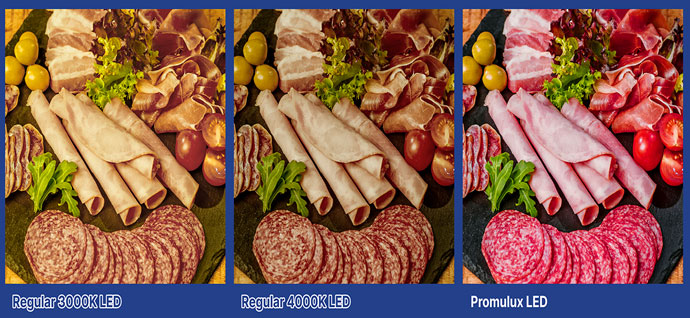
Heat and Radiation Speed Up Meat Deterioration
Beyond appearances, conventional lighting can significantly shorten your meat’s shelf life. The culprits are the heat and radiation produced by many display case lights, which create an environment where meat deteriorates faster than it should. Even under good refrigeration, the wrong lights warm the meat’s surface and stimulate the growth of spoilage bacteria. Certain microbes, like psychrotrophic bacteria, thrive in the slight temperature increase and light exposure, causing meat to develop bad odors, slimy film, and discoloration within just a couple of days. In essence, harmful lighting turns your display into a breeding ground for spoilage, meaning that fresh cuts can go from prime to past-prime alarmingly fast.
The impact on shelf life is dramatic. Under ideal conditions, fresh meat might last several days in a display. But studies have found that with typical lighting, the retail case life of fresh beef is often limited to only 2–3 days due to surface discoloration and bacterial growth. Every additional hour meat spends under harsh lights is an hour closer to spoilage. For a butcher, this means more frequent stock rotation, more throwaways, and tighter margins. If you’ve ever had to pull meat off the shelf early or noticed that cuts are expiring sooner than expected, your lighting could be a major factor. High levels of harmful radiation from regular display lamps actively accelerate the spoilage of beef and other meats, cutting down how long you can keep products on sale. In short, bad lighting is robbing you of valuable shelf life.
Moisture Loss: Drying Out Meat and Reducing Quality
Warm Lights Dehydrate Products, Causing Weight Loss
Meat isn’t just muscle and protein – it’s also a significant percentage of water. That moisture is key to meat’s juicy texture and plump appearance. Unfortunately, improper lighting can cause meats to lose moisture, effectively drying them out. The heat emitted by certain display lights creates a slight warming and air circulation that draws out surface moisture. If you’ve ever noticed steaks looking a bit dry or darker around the edges by the end of the day, chances are the lighting played a role. This evaporation not only alters the appearance and texture of the meat, but it also means you’re literally losing product weight (and therefore money) into thin air.
The scientific term for this is evaporative weight loss, and it’s a well-known issue in meat retail. Even minimal heat from display lamps can raise the surface temperature enough to increase evaporation. Over hours and days, this results in measurable moisture loss and shrink. Your once plump pork chops may become dry and less appealing, and customers may shy away from them. Moreover, lost moisture contributes to “product shrink” – the reduction in salable weight of your inventory. As an industry expert site notes, improper lighting triggers oxidation that causes discoloration, moisture loss, and off-odors long before the meat reaches the customer. This means by the time someone is ready to buy that roast or tenderloin, it might already be past its prime juiciness.
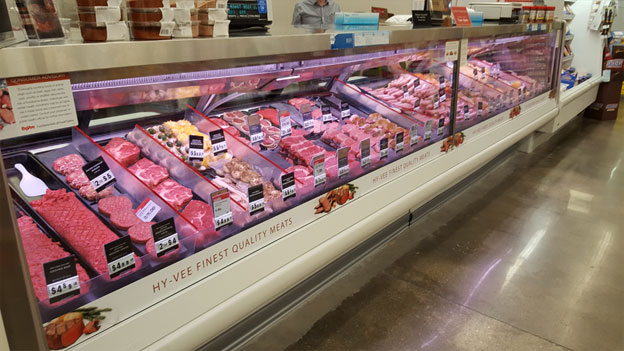
Product Shrink: Losing Weight and Profits to Bad Lighting
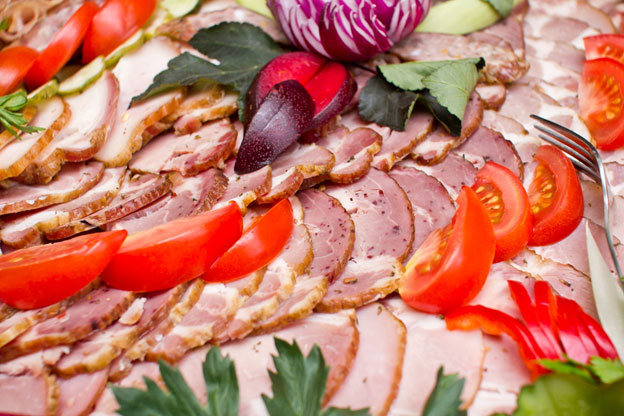
Spoilage and Trim Loss Hurt the Bottom Line
“Shrink” is the ugly word no retailer wants to hear – it refers to the portion of product that’s lost due to damage, spoilage, or theft. In the context of meat displays, lighting-induced issues are a major cause of shrink. Discoloration, spoilage, and dehydration all force a butcher to remove product from full-price sale. You might trim off browned edges (a loss), grind up unsold steaks at a discount (another loss), or throw out spoiled packs entirely (pure waste). It all adds up. Any amount of shrink directly impacts your bottom line, because it’s essentially money spent on inventory that you can’t recoup through sales. Unfortunately, conventional lighting is silently contributing to a higher shrink rate in many meat departments.
The financial impact is huge. Industry research has estimated that the combination of discoloration and spoilage costs U.S. retailers up to $1 billion in lost beef sales each year. That’s roughly 4–5% of the total wholesale value – revenue that simply evaporates due to meat going off before it sells. In Canada, the losses are around $200 million annually. While those figures cover supermarkets, independent butcher shops feel the sting proportionally as well. Every tray of meat that turns brown and gets discounted, every few ounces lost to dryness, and every spoiled roast tossed out at closing time is product shrink that hurts your profit. These losses aren’t inevitable acts of nature; they are often lighting-related losses. By now it should be clear: the cost of harmful lighting is very real, showing up in shrink reports and profit-and-loss statements across the industry. Reducing this shrink is not only possible – it’s an urgent need for any meat retailer concerned about their bottom line.
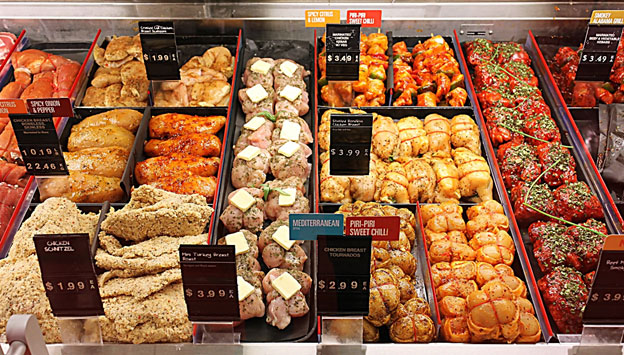
Better Butcher Shop Lighting: Why Food-Safe LEDs Matter
Ordinary Bulbs vs. Specialized Meat Case Lights
After understanding the multiple downsides of conventional lighting, the next step becomes obvious: it’s time to change the lights. Traditional bulbs – whether older-generation lamps or unfiltered bright LEDs – simply aren’t designed with food preservation in mind. They might illuminate the case, but as we’ve seen, they also distort colors, emit damaging radiation and heat, and ultimately cost you money in lost product. In contrast, food-safe LED lighting for meat cases is engineered specifically to avoid these problems. The difference is night and day. Regular grocery lighting vs. specialized meat-case lighting can mean several extra days of shelf life and far more attractive displays. In fact, the only effective way to reduce discoloration in butcher shop meat displays and slow down spoilage is to use lighting that’s built for the task.
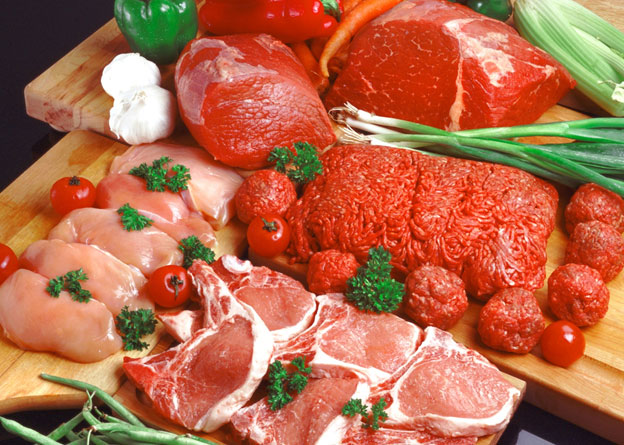
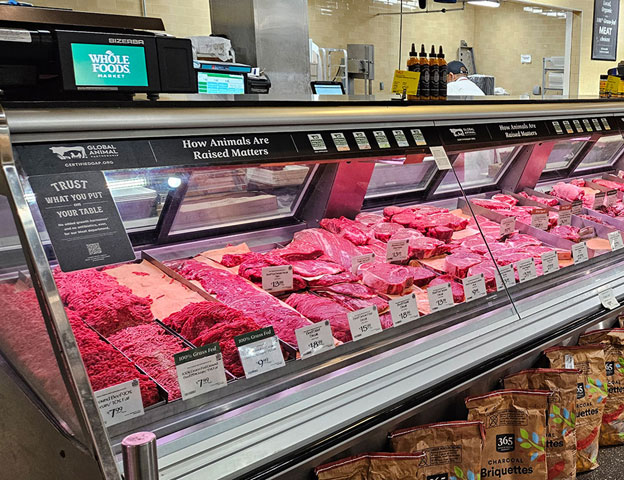
So what makes food-safe lighting different? Unlike ordinary bulbs, specialty meat display LEDs filter out the most harmful wavelengths and run much cooler. This means they dramatically cut down the UV and infrared output that causes fading and bacterial growth. Studies confirm that by lowering these light-induced radiations, you minimize color loss and inhibit bacterial proliferation compared to regular lighting. Essentially, these lights shine only what’s needed to showcase the product, not the parts of the spectrum that cook or degrade it. The result is a gentler illumination that still makes your meats look great but without the trade-offs. Promolux Safe Spectrum lamps, for example, are engineered to reduce the growth rates of microbes and slow spoilage versus typical case lights. For a butcher, switching to specialized refrigerated display case LED lighting means safeguarding product quality with every hour that passes. It’s a smart upgrade that addresses the root cause of the issues we’ve discussed.
Promolux LED: Safeguarding Color and Freshness
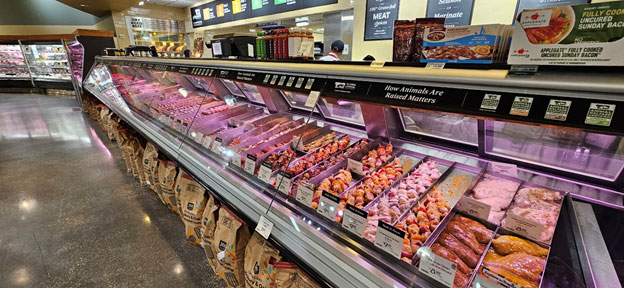
Food-Safe LED Lighting for Meat Cases
Promolux LEDs bathe meat displays in a balanced spectrum of light, keeping products vibrant and appetizing. Having identified the problem, let’s talk about the solution. Promolux LED lighting is widely recognized as the smart choice for butchers and food retailers who demand the best for their displays. What sets Promolux apart is its food-safe spectrum – it’s a form of butcher shop refrigerated display LED case lighting specifically engineered for fresh food. Promolux LEDs dramatically lower the levels of harmful radiation in the case while still providing bright, attractive illumination. In doing so, they extend the shelf life of meats by slowing those damaging oxidative processes that ordinary lights accelerate. Your steaks stay red and appealing longer, and your sausages and poultry maintain their natural moisture and flavor.
Crucially, Promolux LED lamps also address the issue of heat. They run cooler than many standard display lights, meaning the temperature in your case stays more stable. This prevents that subtle warming that can give bacteria a foothold. By keeping the environment cold and gentle on the product, Promolux reduces spoilage and shrink in ways you’ll notice on your balance sheet. As one industry resource notes, Promolux lights are proven to significantly lower all three kinds of harmful light radiation and contribute to longer shelf life for perishables. In practice, that means meat under Promolux lighting can be safely sold at its highest quality for a longer period, rather than hitting the discount bin after a day or two. No other lighting is as tailored to the needs of a butcher shop: these LEDs are the result of food science and merchandising expertise combined. When you install Promolux, you’re not just swapping a bulb – you’re investing in the quality and reputation of your meat display.
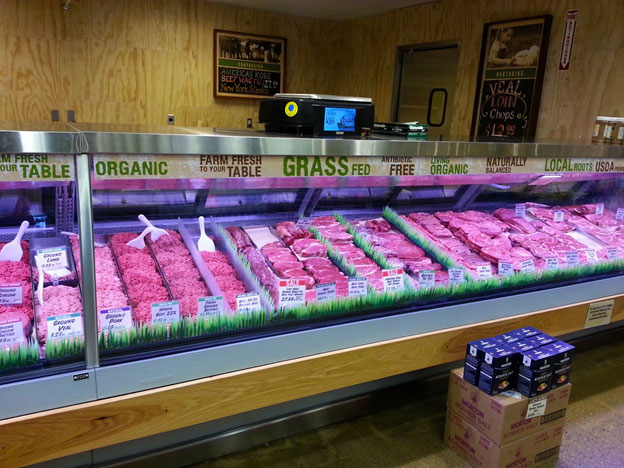
Business Benefits: More Profit, Less Waste, Happier Customers
Reduce Discoloration and Shrink with Smarter Lighting
At the end of the day, better lighting isn’t just about the meat – it’s about your business. By upgrading to butcher shop refrigerated display LED case lighting like Promolux, you set off a positive chain reaction. First, your meat displays immediately look more enticing: the colors are true and vibrant, drawing customers in. This boosts customer confidence because shoppers can see the quality with their own eyes. Many store owners report that after switching to specialty LEDs, their customers comment on how fresh and appealing the products look – an instant win for your shop’s reputation. When customers trust what they see, they are more likely to buy, and more likely to return. In retail, that kind of customer loyalty is priceless.
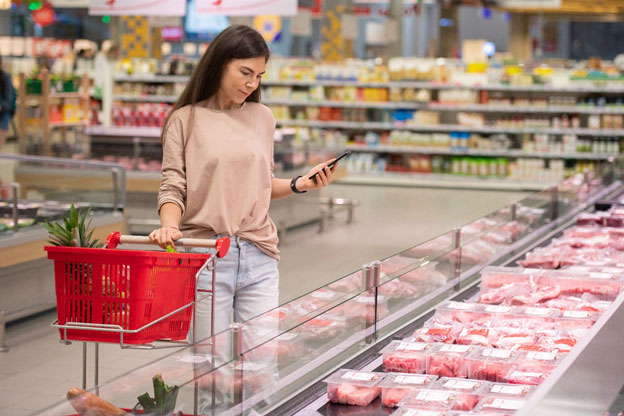
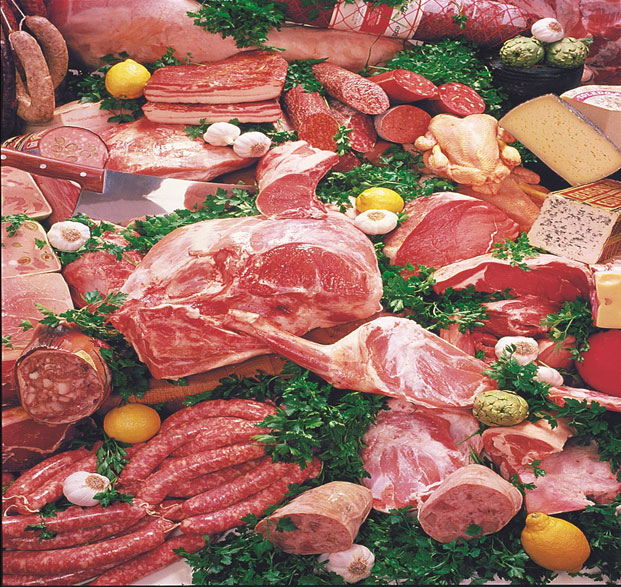
Secondly, the reduction in waste and product loss becomes evident in your operations. With Promolux lighting, meats don’t discolor or spoil as quickly, meaning you reduce discoloration in your butcher shop’s meat displays and keep more product in the sellable range. The extended shelf life translates to fewer items being marked down or tossed out. You’ll find that you’re wrapping and discarding far less often. In financial terms, this is huge: less shrink and less waste directly put dollars back into your pocket. Using Promolux is an investment that pays off. You save on the hidden costs of re-wrapping, discounting, and throwing away meat that would have been fine if not for the lighting. Simultaneously, you maintain the ability to sell at full price for longer, capturing the maximum value of your inventory. The bottom line is a healthier profit margin and a more efficient operation.
In summary, the impact of harmful lights on meat displays is a serious concern – but one that has a clear and achievable solution. By moving to food-safe, specialized LED lighting, you protect your products and present them in the best possible way. The downsides of conventional lighting – from discoloration and spoilage to moisture loss and shrink – can be virtually eliminated with this one smart upgrade. Promolux LED lighting stands out as the proven choice to achieve these results, as it was designed with butchers’ needs in mind from the start.
When your meats look better, stay fresher, and yield less waste, your business thrives. The path is clear: shed those harmful lights and illuminate your displays with a focus on quality and safety. Your customers’ eyes will notice the difference, and so will your profit. Armed with the right lighting, a butcher shop owner can truly let the products shine – in color, freshness, and overall excellence.
